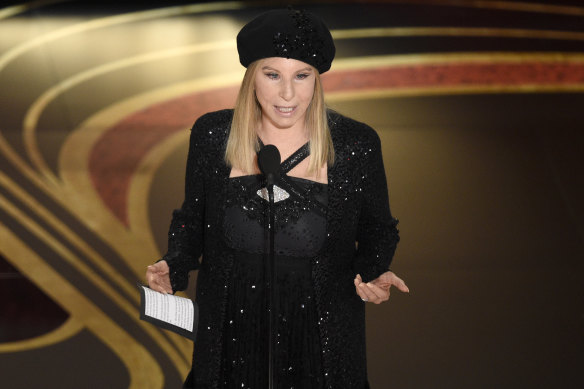This was published 5 months ago
Opinion
Why the Streisand effect could be morphing into the Gina effect
David Astle
Crossword compiler and ABC Radio Melbourne presenterTwenty years ago, a helicopter swept Malibu, photographing the chalky cliffs. Kenneth Adelman, a Shakespeare-loving diplomat, had funded the flight for the California Coastal Records Project. All up, over months, the team took 12,000 snaps, posting the images online for geo-research. The exercise embodied citizen science, focused and efficient, until the turbulence struck.
The problem was Image 3850, a marzipan castle with balconies and pool, perched above the beach. Barbra Streisand, the house’s owner, objected to her hideaway being viewable to the world. So she sued, on a Hollywood scale, seeking $50 million in damages for loss of privacy.

Before there was Gina, there was Barbra.Credit: AP
Cutting a long case short, Streisand lost the suit, obliging her to pay $177,000 for Adelman’s troubles, Worse, Image 3850 became the holy grail of realty porn, an aerial shot every nosy sod wanted to see. Seeking privacy, Barbra had opened her wrought gates to scrutiny, thereby coining what became known as the Streisand effect.
Countless examples have emerged since, from shambolic cover-ups to censored books, from news embargos to wishful gag orders. Though just as many instances predate the Malibu imbroglio, as Barbra did not invent the Streisand effect. A Chinese proverb was already there, claiming in translation: “Wishing to cover, more conspicuous”.
A wisdom that mining magnate Gina Rinehart learnt last week, thanks to a portrait found in Canberra. If you don’t know the story, I can only presume you’ve just returned from a 10-day ordeal at sea, eating raw seagulls off the grid. In summary, Rinehart wasn’t pleased by her caricature hanging in the National Gallery, a portrait by Western Aranda artist Vincent Namatjira.
Pallid pink in tone, with fearful gaze and double chin, the likeness appears horror-struck and appalled. It was a vibe US talk show host Stephen Colbert channelled, sharing the controversy to his 2.5 million viewers last week: “I’m no art expert but in this portrait I believe the artist really captured her expression at the moment she saw this portrait.”

US talk show host Stephen Colbert covered the Gina Rinehart portrait story on his show.Credit: Getty Images
CNN also ran the story, as did BBC, plus scores of other sites worldwide. Consult Google now, and the auto-suggestions tagging Gina Rinehart in your search window range from picture to portrait, art to meme, relegating net worth to seventh. Peek behind the Wiki pages on either Rinehart or the artist, Namatjira, and you’ll see page views have leapt from a handful to a truckload.
Likewise the foot traffic of gallery visitors in Canberra has exploded, with patrons making a beeline to Rinehart’s visage as much as the Louvre hordes swamp La Gioconda. (“Tell me, what is the secret behind the woman’s enigmatic grimace?” ) The whole frisson evokes the French idea of “success de scandale” – where any publicity is good publicity. Unless you want the publicity to evaporate.
Perhaps here I should admit some empathy for Rinehart, just as I felt Barbra Streisand had her rights to keep her palace hush-hush. The ego is a brittle thing, no matter your bank balance. For the record, back in 2011, Amanda Marburg painted me as a plasticine effigy for the Archibald Prize, complete with button eyes and viper afro.
As it happened, I liked the likeness. But then again, even if I didn’t, I probably would have kept shtum about the bloody thing. History, and a Malibu helicopter, have taught us that much. Curiosity might have killed the cat, but for curious humans, we’re just dying to know. The moment you tell us to look away, we can’t stop gawking.
The Booklist is a weekly newsletter for book lovers from books editor Jason Steger. Get it delivered every Friday.